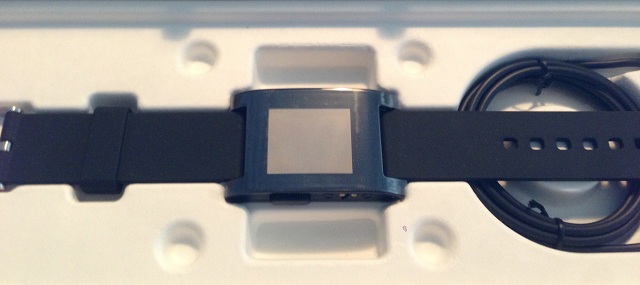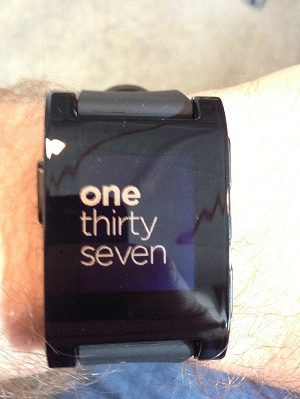
After several months of patient waiting, I finally received my Pebble in the mail a few weeks ago. This Pebble is not the kind that gets stuck in your shoe (hopefully). It's a brand-spankin'-new, Kickstarter-funded "smart watch"—an e-paper bracelet that connects to your iOS and Android devices, which means you can tell the time and do some other cool stuff too.
The "other cool stuff" is the part that had Kickstarter backers excited in early 2012—excited to the tune of $10.2 million. During the fundraiser (which ended in May of last year), backers who pledged $99 or more were promised one Pebble watch, which now retails for $150. While the device is not perfect, it's a rather interesting step forward that should culminate in a healthy platform later this year.
First impressions
At its most basic level, Pebble tells the time. You may scoff at that—it's a watch; of course it tells the time. But it does its time-telling really well. It currently ships with three default watch faces, and there are 12 others that you can load onto the watch through the companion app (free on iOS and Android). By far my favorite custom watch face is "Fuzzy Time," which rounds the current time to the nearest 5-minute interval and translates that number to what you might say if your friend asked you the time. While perhaps trivial, I love this rough approximation of time. Rarely do I need to know that it's 5:13:23 pm, but seeing that it's "quarter after five" is awesome.

When you first glance at the Pebble, you see the time as presented by your currently selected watch face. You can navigate away from the watch face and through the watch's operating system using the four physical buttons on the watch: back, up, select, and down. The main screen consists of your apps: Music, Alarm, Watchfaces, and Settings. With Music, you can use Pebble's hardware buttons to perform basic actions on your phone's currently playing music, such as pause, play, and skip backward or forward. The alarm is pretty straightforward. Watchfaces lets you browse and select currently installed watch faces.
Pebble promises seven days of uptime, and in my experience so far, it's been right on. This is due in a large part to the combination of the e-paper display and the use of low-energy Bluetooth. It runs on an ARM Cortex-M3 microcontroller. It will drain your phone's battery just a bit—Pebble says to expect a power drain of between 5 and 10 percent on your iOS or Android phone.
Cool Tricks
Do you like to go swimming, happen to take regular showers, or just simply enjoy walking outside in the rain? Then you'll be delighted to know that the watch is waterproof and rated at 5 ATM. If you're like me and weren't sure what that means, it means you can use it down to 50m, or 164ft, underwater. Because of this, Pebble uses a proprietary magnetic charging port which plugs into a USB port (no holes means no place for water to leak in).

All that is well and good, but what I'm really excited about, and why I backed the Kickstarter campaign in the first place, is what lies ahead for third-party Pebble app developers. The first major opportunity for third party developers is building customized watch faces. While simple, I think there's a lot of potential for exciting design ideas. My first idea was to take "Fuzzy Time" and make it even fuzzier. Why stop at updating every five minutes, when most of the time I don't care about intervals beyond 15 minutes? Alternatively, you could get inspiration from classic watches and create your own. Maybe go abstract and mimic the clock in Union Square in New York City.
Founder and CEO Eric Migicovsky refers to the Pebble as a heads-up display for your phone. In this first iteration, it's capable of displaying notifications for phone calls, e-mails, and text messages. I used to compulsively check my phone to find the time and to see if I had any new messages or phone calls that I had missed. Now I simply glance at my wrist, and voila, I know that it's ten to nine, and I have a new text message from my friend.
Of course, what we all want is third-party app integration. There will be two flavors of this. First, Web apps can simply use Pebble as a notification recipient. Log in to Pebble from your Web app, authenticate (presumably through oAuth), and you can receive notifications from that service. The second approach will allow native apps to use the Pebble as a secondary output in real time. I was thinking the other day as I was using a maps app for walking directions that it would be great if the Pebble would buzz right before I was supposed to turn.
What's the timing on all this? The Watchface SDK is due out in mid-April, according to a recent update on Kickstarter. It sounds like we'll have to wait a little longer for third party apps.
Expect firmware updates every few weeks. Updating is a breeze—the companion app downloads and installs over-the-air, no wires needed. The latest came with a few new watch faces, as well as the classic game Snake.
Miss out on the Kickstarter campaign? You can pre-order your own Pebble at getpebble.com for $150, which will ship in "early 2013." The watch comes in Jet Black, Arctic White, Cherry Red, Orange, and Grey.
reader comments
139